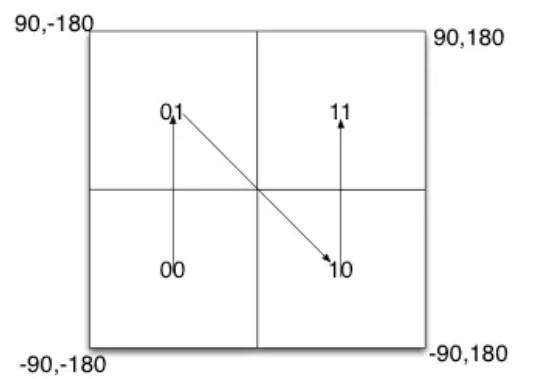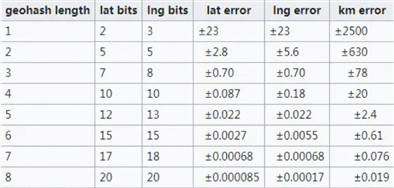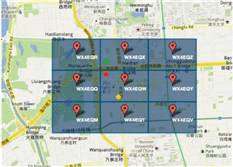Geohash算法就是将经纬度编码,将二维变一维,给地址位置分区的一种算法。
基本原理:GeoHash是一种地址编码方法。他能够把二维的空间经纬度数据编码成一个字符串


可以看到,划分的区域更多了,也更精确了。geohash算法就是基于这种思想,划分的次数更多,区域更多,区域面积更小了。通过将经纬度编码,给地理位置分区
Geohash算法一共有三步。
首先将经纬度变成二进制。
比如这样一个点(39.923201, 116.390705)
纬度的范围是(-90,90),其中间值为0。对于纬度39.923201,在区间(0,90)中,因此得到一个1;(0,90)区间的中间值为45度,纬度39.923201小于45,因此得到一个0,依次计算下去,即可得到纬度的二进制表示,如下表:

10111000110001111001
同理可以得到经度116.390705的二进制表示为:
11010010110001000100
第2步,就是将经纬度合并。
经度占偶数位,纬度占奇数位,注意,0也是偶数位。
11100 11101 00100 01111 00000 01101 01011 00001
第3步,按照Base32进行编码
Base32编码表的其中一种如下,是用0-9、b-z(去掉a, i, l, o)这32个字母进行编码。具体操作是先将上一步得到的合并后二进制转换为10进制数据,然后对应生成Base32码。需要注意的是,将5个二进制位转换成一个base32码。上例最终得到的值为
wx4g0ec1
Geohash比直接用经纬度的高效很多,而且使用者可以发布地址编码,既能表明自己位于北海公园附近,又不至于暴露自己的精确坐标,有助于隐私保护。
编码越长,表示的范围越小,位置也越精确。因此我们就可以通过比较GeoHash匹配的位数来判断两个点之间的大概距离。

geohash算法有两个问题。首先是边缘问题。

如图,如果车在红点位置,区域内还有一个黄点。相邻区域内的绿点明显离红点更近。但因为黄点的编码和红点一样,最终找到的将是黄点。这就有问题了。
要解决这个问题,很简单,只要再查找周边8个区域内的点,看哪个离自己更近即可。
另外就是曲线突变问题。
本文第2张图片比较好地解释了这个问题。其中0111和1000两个编码非常相近,但它们的实际距离确很远。所以编码相近的两个单位,并不一定真实距离很近,这需要实际计算两个点的距离才行。
在众多NoSQL数据库,MongoDB是一个优秀的产品。其官方介绍以下:
MongoDB (from "humongous") is a scalable, high-performance, open source, document-oriented database.html
看起来,十分诱人!值得说明的是,MongoDB的document是以BSON(Binary JSON)格式存储的,彻底支持Schema Free。这对地理空间数据是十分友好的。由于有著名的GeoJSON可供使用。另外OGR库也支持将Geometry类型导出为JSON格式。mongodb
本文将尝试使用OGR库把Shapefile导入到MongoDB存储,而后创建空间索引,进行空间查询。数据库
著名的Foursquare使用了MongoDB数据库。json
MongoDB+Python+Pymongo+GDAL for Python数组
关于MongoDB和Python安装,本文不作介绍。关于GDAL for Python的安装,可见个人另外一篇博文:http://blog.3sdn.net/311.html服务器
在继续本文以前,请先启动你的MongoDB服务器。本文默认采用以下服务器参数:
Server:localhost
Post:27017
Database Name:gisdbapp
这里我直接提供代码,代码中已经有比较详尽的注释了。代码基本源于“引文1”,只是作了些改动,将MongoDB的Geometry的存储格式由wkt改为json。你可直接复制并运行下面的代码,固然须要修改一下Shapefile路径和MongoDB服务器相关参数。性能
import os
import sys
import json
from pymongo import json_util
from pymongo.connection import Connection
from progressbar import ProgressBar
from osgeo import ogr测试
def shp2mongodb(shape_path, mongodb_server, mongodb_port, mongodb_db, mongodb_collection, append, query_filter):
"""Convert a shapefile to a mongodb collection"""
print ‘Converting a shapefile to a mongodb collection ‘
driver = ogr.GetDriverByName(‘ESRI Shapefile’)
print ‘Opening the shapefile %s…’ % shape_path
ds = driver.Open(shape_path, 0)
if ds is None:
print ‘Can not open’, ds
sys.exit(1)
lyr = ds.GetLayer()
totfeats = lyr.GetFeatureCount()
lyr.SetAttributeFilter(query_filter)
print ‘Starting to load %s of %s features in shapefile %s to MongoDB…’ % (lyr.GetFeatureCount(), totfeats, lyr.GetName())
print ‘Opening MongoDB connection to server %s:%i…’ % (mongodb_server, mongodb_port)
cOnnection= Connection(mongodb_server, mongodb_port)
print ‘Getting database %s’ % mongodb_db
db = connection[mongodb_db]
print ‘Getting the collection %s’ % mongodb_collection
collection = db[mongodb_collection]
if append == False:
print ‘Removing features from the collection…’
collection.remove({})
print ‘Starting loading features…’
# define the progressbar
pbar = ProgressBar(maxval=lyr.GetFeatureCount()).start()
k=0
# iterate the features and access its attributes (including geometry) to store them in MongoDb
feat = lyr.GetNextFeature()
while feat:
mOngofeat= {}
geom = feat.GetGeometryRef()
mOngogeom= geom.ExportToJson()
# store the geometry data with json format
mongofeat[‘geom‘] = json.loads(mongogeom,object_hook=json_util.object_hook)
# iterate the feature’s fields to get its values and store them in MongoDb
feat_defn = lyr.GetLayerDefn()
for i in range(feat_defn.GetFieldCount()):
value = feat.GetField(i)
if isinstance(value, str):
value = unicode(value, "gb2312")
field = feat.GetFieldDefnRef(i)
fieldname = field.GetName()
mongofeat[fieldname] = value
# insert the feature in the collection
collection.insert(mongofeat)
feat.Destroy()
feat = lyr.GetNextFeature()
k = k + 1
pbar.update(k)
pbar.finish()
print ‘%s features loaded in MongoDb from shapefile.’ % lyr.GetFeatureCount()
input_shape = ‘/home/evan/data/map/res4_4m/XianCh_point.shp’
mongodb_server = ‘localhost’
mongodb_port = 27017
mongodb_db = ‘gisdb’
mongodb_collection = ‘xqpoint’
filter = ”spa
print ‘Importing data to mongodb…’
shp2mongodb(input_shape, mongodb_server, mongodb_port, mongodb_db, mongodb_collection, False, filter)
在MongoDB的Shell中执行:
>db.xqpoint.findOne()
结果以下:
{
"_id" : ObjectId("4dc82e7f7de36a5ceb000000"),
"PERIMETER" : 0,
"NAME" : "漠河县",
"PYNAME" : "Mohe Xian",
"AREA" : 0,
"ADCODE93" : 232723,
"CNTYPT_ID" : 31,
"CNTYPT_" : 1,
"geom" : {
"type" : "Point",
"coordinates" : [
122.53233,
52.968872
]
},
"ID" : 1031,
"PN" : 1,
"CLASS" : "AI"
}
这即是一个document,使用JSON格式,一目了然。其中的"geom"即为Geometry类型的数据,即地理空间数据,也是采用JSON格式存储,这样后续的空间索引与空间查询将十分方便。
MongoDB原生地支持了空间索引与空间查询,这一点比PostgreSQL方便,再也不须要使用PostGIS进行空间扩展了。至于性能,我还没测试,在此不敢妄加评论。
>db.xqpoint.ensureIndex({‘geom.coordinates’:’2d’})
是否是十分简单?其它参数及用法请自行查看MongoDB手册。
>db.xqpoint.find({"geom.coordinates":[122.53233,52.968872]})
便可查询到上述“莫河县”这个点。固然,像这种精确查询,实际应用并很少。实际应用的空间查询大多为范围查询。MongoDB支持邻域查询($near),和范围查询($within)。
>db.xqpoint.find({"geom.coordinates":{$near:[122,52]}})
上述查询语句查询点[122,52]附近的点,MongoDB默认返回附近的100个点,并按距离排序。你也能够用limit()指定返回的结果数量, 如:>db.xqpoint.find({"geom.coordinates":{$near:[122,52]}}).limit(5)
另外,你也能够指定一个最大距离,只查询这个距离内的点。
>db.xqpoint.find({"geom.coordinates":{$near:[122,52],$maxDistance:5}}).limit(5)
MongoDB的find()方法可很方便的进行查询,同时MongoDB也提供了geoNear命令,用于邻域查询。
>db.runCommand({geoNear:"xqpoint",near:[122,56],num:2})
上述语句用于查询[122,56]点附近的点,并只返回2个点。结果以下:
{
"ns" : "gisdb.xqpoint",
"near" : "1110011000111101111100010000011000111101111100010000",
"results" : [
{
"dis" : 3.077515616588727,
"obj" : {
"_id" : ObjectId("4dc82e7f7de36a5ceb000000"),
"PERIMETER" : 0,
"NAME" : "漠河县",
"PYNAME" : "Mohe Xian",
"AREA" : 0,
"ADCODE93" : 232723,
"CNTYPT_ID" : 31,
"CNTYPT_" : 1,
"geom" : {
"type" : "Point",
"coordinates" : [
122.53233,
52.968872
]
},
"ID" : 1031,
"PN" : 1,
"CLASS" : "AI"
}
},
{
"dis" : 4.551319677334594,
"obj" : {
"_id" : ObjectId("4dc82e7f7de36a5ceb000001"),
"PERIMETER" : 0,
"NAME" : "塔河县",
"PYNAME" : "Tahe Xian",
"AREA" : 0,
"ADCODE93" : 232722,
"CNTYPT_ID" : 66,
"CNTYPT_" : 2,
"geom" : {
"type" : "Point",
"coordinates" : [
124.7058,
52.340332
]
},
"ID" : 1059,
"PN" : 1,
"CLASS" : "AI"
}
}
],
"stats" : {
"time" : 0,
"btreelocs" : 85,
"nscanned" : 85,
"objectsLoaded" : 4,
"avgDistance" : 3.814417646961661,
"maxDistance" : 4.551319677334594
},
"ok" : 1
}
固然,咱们也可附加条件查询条件,如查询[122,56]附近的且"PYNAME"为"Tahe Xian"的点:
>db.runCommand({geoNear:"xqpoint",near:[122,56],num:2,query:{"PYNAME":"Tahe Xian"})
返回结果以下:
{
"ns" : "gisdb.xqpoint",
"near" : "1110011000111101111100010000011000111101111100010000",
"results" : [
{
"dis" : 4.551319677334594,
"obj" : {
"_id" : ObjectId("4dc82e7f7de36a5ceb000001"),
"PERIMETER" : 0,
"NAME" : "塔河县",
"PYNAME" : "Tahe Xian",
"AREA" : 0,
"ADCODE93" : 232722,
"CNTYPT_ID" : 66,
"CNTYPT_" : 2,
"geom" : {
"type" : "Point",
"coordinates" : [
124.7058,
52.340332
]
},
"ID" : 1059,
"PN" : 1,
"CLASS" : "AI"
}
}
],
"stats" : {
"time" : 45,
"btreelocs" : 2095,
"nscanned" : 2096,
"objectsLoaded" : 2096,
"avgDistance" : 4.551319677334594,
"maxDistance" : 4.551319677334594
},
"ok" : 1
}
MongoDB的$within操做符支持的形状有$box(矩形),$center(圆形),$polygon(多边形,包括凹多边形和凸多边形)。全部的范围查询,默认是包含边界的。
查询一个矩形范围,须要指定矩形的左下角和右上角两个坐标点,以下:
> box = [[80,40],[100,50]]
> db.xqpoint.find({"geom.coordinates":{$within:{$box:box}}})
查询一个圆形范围,须要指定圆心坐标和半径,以下:
> center = [80,44]
> radius =5
> db.xqpoint.find({"geom.coordinates":{$within:{$center:[center,radius]}}})
查询一个多边形范围,须要指定多边形的各个顶点,能够经过一个顶点数组或一系列点对象指定。其中,最后一个点是默认与第一个点链接的。以下:
> polygon1 = [[75,35],[80,35],[80,45],[60,40]]
> db.xqpoint.find({"geom.coordinates":{$within:{$polygon:polygon1}}})
或者
> polygon2 = {a:{75,35},b:{80,35},c:{80,45},d:{60,40}}
> db.xqpoint.find({"geom.coordinates":{$within:{$polygon:polygon2}}})
注意:MongoDB 1.9及以上版本才支持多边形范围查询。
P.S. MongoDB还支持复合索引,球面模型(可简单理解为投影吧),多位置文档(Multi-location Documents,即一个文档中包括多个Geometry),可参见“引文2”或MongoDB手册。

 京公网安备 11010802041100号 | 京ICP备19059560号-4 | PHP1.CN 第一PHP社区 版权所有
京公网安备 11010802041100号 | 京ICP备19059560号-4 | PHP1.CN 第一PHP社区 版权所有